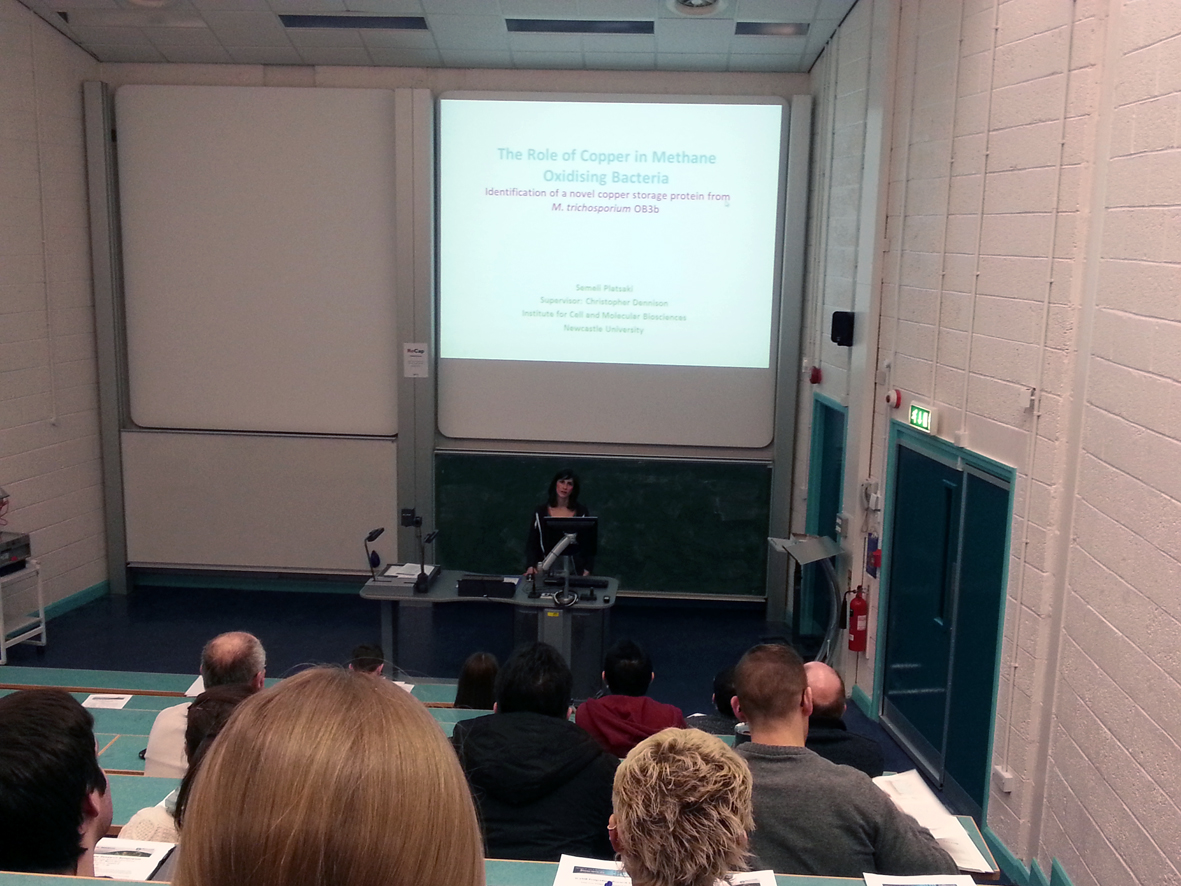Once a year the final year PhD students in ICaMB have a one day symposium to present their data. Here we ask some of these students to tell us how they found the occasion and discuss the projects they found particularly interesting.
By Thomas Kinsman, Alexander Egan, Emma Button and Nichola Conlon
The ICaMB PGR Symposium was held on 25 March 2013. This annual symposium provides not only an excellent opportunity for final year PhD students to present their work to a mixed scientific audience of fellow students, research technicians, post docs and more senior researchers, but is also an excellent demonstration of the diversity of top quality research that is going on in ICaMB labs. The symposium and lunch were generously sponsored by GT Vision.
Session 1 – Reported by Thomas Kinsman (Lewis Lab)
The first session was centred on the study of DNA, yet talks ranged from the molecular biology of DNA polymerase processivity to the role of extracellular DNA in dental plaque biofilms. In addition to enabling me to gain a greater appreciation of the work that goes on in other labs within ICaMB, it was interesting that one of the speakers made a point of saying that preparing their talk had been very useful because it had made them realise they had enough results to write-up their PhD – I had not fully appreciated that this was another value of these talks!
Session 2 – Reported by Alex Egan (Vollmer Lab)
The second session of the symposium featured the work of students who look at various aspects of bacterial cell biology including; cell wall synthesis and cell division, bacterial cell motility, copper transport and storage and DNA replication. What immediately stands out from that list is the vast range of biological problems we work on here in ICaMB, and that’s just a small representation of the bacterial labs here. A positive impact of this vast range is that it creates an excellent centre for diverse knowledge, not just in gross terms, but in the myriad of different cellular and molecular techniques. With use of relatively simple yet elegant microscopy to study biological problems on cellular levels to the use of biochemical approaches to characterise the molecular basis of bacterial processes, it highlights that there’ll always be someone with experience who can provide advice and insight into almost any approach to biology. Having been on both the giving and receiving end of this, I believe it’s one of the great strengths of the symposium.
 Session 3 – Reported by Emma Button (Veal Lab)
Session 3 – Reported by Emma Button (Veal Lab)
Session three was an exciting session in which talks ranged from the important interactions between the host and gut microbiota to mathematical equations used to refine a statistical modelling process that identifies subtle interactions involved telomere maintenance. Highlights of the session included a talk on the diverse roles of a peroxiredoxin (PRDX-6) in stress resistance and ageing, and a description of the importance of a DNA licensing protein (Cdt-1) and how it controlled DNA replication during embryo development in the African clawed frog, Xenopus laevis.
Session 4 – Reported by Nichola Conlon (Thwaites Lab)
The final session had talks that were all related to the gut, yet ranged from studies at a molecular level to in vivo human clinical trials. The first talk demonstrated how understanding the structure of mammalian amino acid transporter proteins in the plasma membrane is vital in understanding the pathology of gastrointestinal diseases and in improving drug specificity and targeting. An interesting insight followed into the mystery surrounding the mechanisms by which enteropathogenic E.coli (EPEC) disrupts the intestinal epithelium to cause diarrhoeal disease. The talk described the ways in which EPEC targets host cell proteins and pathways and highlighted the complexity in understanding such a common disease. Focus then shifted to the gut in its entirety with an intriguing description of an in vitro ‘model gut’, which is used to study the effects of various compounds on digestion. This model has proved effective in identifying alginate as a novel lipase inhibitor that can inhibit fat digestion similar to a current commercially available drug that is plagued by unwanted side effects. In vitro then moved to in vivo with the final talk which described a human clinical study in which ileostomy patients were used to assess the ability of alginate-enriched bread to inhibit fat digestion in vivo. Preliminary results revealed that, as observed in the model gut, alginate can also inhibit fat digestion in vivo when added as a supplement to food. The idea is that alginate could be incorporated into everyday foods, such as a loaf of bread, to try and combat obesity in a ‘health by stealth’ manner.
Personally, I found the symposium a complete success: everybody in attendance, students and staff alike, seemed to benefit in different ways from the experience. As a first year student in my lab said to me, they are looking forward to their turn in two years time.
Links
Institute of Cell and Molecular Biosciences (ICaMB) at Newcastle University
Postgraduate research programmes in ICaMB
The 2013 ICaMB Postgraduate Research Symposium
PANIC, the postgraduate network of ICaMB

